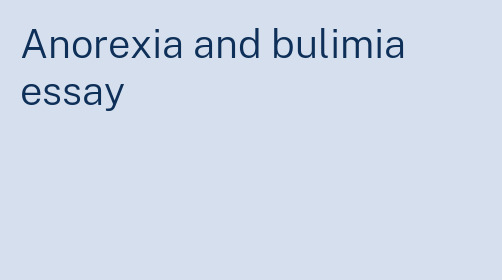- Published: September 22, 2022
- Updated: September 22, 2022
- University / College: Wake Forest University
- Level: Intermediate School
- Language: English
- Downloads: 44
Anorexia Nervosa Anorexia is an eating disorder, which makes people lose more weight than they are healthy expected to be at that age and height (Treasure, 2013). People with this condition tend to have a strong fear for weight gain. Anorexia Nervosa affects both the body and mind. It is a health condition that is more prevalent in women than male. Women, for example, severely limit the amount of food they take to become extremely thin. It also results when the victims exercise too much, or use other methods such as drugs to reduce their weight (Treasure, 2013).
Anorexia Nervosa victims are usually women who deny the fact that they have this problem. People who have anorexia are extremely thin, have a strong fear of becoming fat or gaining weight, refuse to maintain their weights at considerable level for her height or age (usually 15 percent or lower than the normal weight), and have not experienced their menstrual cycle for more than three months (Strober et al. 1997). Additionally, they cut food into small pieces and move around with the plate instead of eating, exercise all the times, visit the bathroom immediately after every meal, fear to eat with others, and use pills to force themselves urinate (Strober et al. 1997). Other symptoms include depression, dry mouth, weak bones, yellow or blotchy skin that is dry, and loss of body fat.
Anorexia Nervosa begins in the teen years, and its early treatment is significant in a person’s health. This is because failure to treat this condition can lead to a lifelong health problem and even death. It can lead to starvation and other health-related problems such as low body weight, heart problems, malnourishment, frail bones, organ weakness, hair loss, discolored nails, fainting, depression, flaky skin and organ failure (Garner et al. 1998). Some people usually die from these symptoms.
References
Garner et al. (1998). Development and validation of a multidimensional eating disorder inventory for anorexia nervosa and bulimia. International Journal of Eating Disorders , 15-34.
Strober, M., Freeman, R., & Morrell, W. (1997). The long-term course of severe anorexia nervosa in adolescents: Survival analysis of recovery, relapse, and outcome predictors over 10–15 years in a prospective study. International Journal of Eating Disorders , 339-360.
Treasure, J. (2013). Anorexia Nervosa: A Survival Guide for Families, Friends and Sufferers. New York: Psychology Press.


